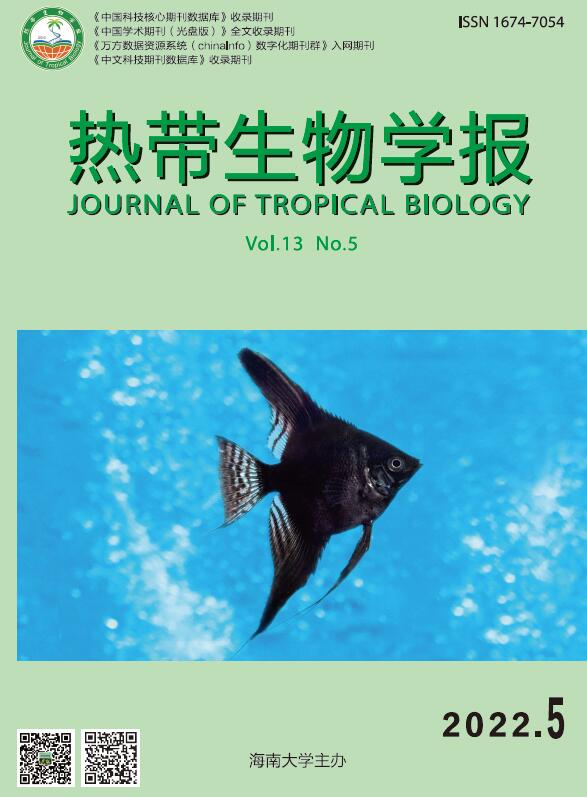-
作为植物生长和生存必需的大量元素氮、磷、钾,对蛋白质、磷酸的合成、酶的激活以及能量传递等代谢过程至关重要[1-3]。研究和分析植物的氮、磷、钾生态化学计量特征可以反映营养元素在植株不同器官中的分配状况和相互关系,确定植株在不同环境中的养分限制因素[4-5],预判植株对环境变化的适应性[6-8]。目前,国内外学者从不同尺度研究了植物化学计量特征对环境、土壤管理、经营措施等的响应[4, 9-14]。研究表明,植物对营养元素的吸收和分配在不同器官的表现不一致[15-17],受植株品种、年限、环境和管理措施等因素的影响下植物的生态化学计量特征也表现出了一定的差异性[18-19]。将植株地上部和地下部器官作为整体,系统地研究其获取土壤养分资源的化学计量特征成为关注的热点[17, 20-21],然而大部分生态化学计量学研究还集中在部分器官之间[22-23]。橡胶树(Hevea brasiliensis)是大戟科橡胶树属植物,为海南热带地区主要的人工生态系统类型之一。不同土壤、施肥措施、树龄、品系和种植材料等对橡胶树的养分积累、分配和循环都有影响[24-26],探讨橡胶苗在施肥影响下对养分分配和利用的特点,旨在揭示橡胶苗对施肥变化的响应和适应性,为海南橡胶经济林的土壤和施肥管理提供理论基础,并丰富经济林树种的生态化学计量学内容。
-
本研究区位于中国热带农业科学院橡胶研究所土壤肥料试验基地,地理位置为109°29′E、19°30′N,海拔高度115 m,试验区属于典型热带季风气候,全年日照时数1 967 h,年均风速为 1~4 m·s−1,年均气温约为 23.5 ℃,年均降水量为1 815 mm。土壤属于花岗岩发育的砖红壤,其基本化学性质(0~20 cm土层):有机质10.23 g·kg−1,全氮0.53 g·kg−1,有效磷6.49 mg·kg−1,速效钾25.90 mg·kg−1,pH4.92。橡胶树品种为‘热研7-33-97’,于2017年11月种植,株行距为2.5 m×7.0 m,试验占地面积为2 746 m2。
-
试验设4个不同施肥量处理(详见表1),随机区组设计, 3次重复,共12个小区,每个小区15株橡胶苗。各小区之间用水泥预制板进行隔离(深度20 cm),以防止不同施肥量处理间的相互影响。试验于2018年4月底进行一次性施肥,距苗木15 cm处挖沟深施后,覆土,于12月底进行破坏性采样。
处理施肥量 尿素 钙镁磷肥 氯化钾 CK 0 0 0 F1 70.0 75.0 37.5 F2 140.0 150.0 75.0 F3 210.0 225.0 112.5 注:氮肥为尿素(海南富岛复合肥有限公司生产,N含量为46%),磷肥为钙镁磷肥(云南昆阳滇白化工有限公司生产,P2O5含量为17%),钾肥为氯化钾(中国农业生产资料集团公司生产,K2O含量为60%)。 -
每个小区随机选取4株无病虫害的橡胶树进行破坏性采样。从田间挖取整株苗木,分别写标签区分并用清水冲洗,带回实验室后再用去离子水冲洗干净,用吸水纸轻拭表面水分。每株苗木分别按根(主根和侧根)、枝条、叶(茎、叶片和叶柄)和主干4个部分称取鲜质量并记录,然后将叶片放置于105 ℃烘箱内杀青半小时,再调至70 ℃烘至恒重,称取干质量并记录,最后用植物粉碎机分别研磨成粉末状,同标签装入密封袋待化学分析。
-
样品用H2SO4−H2O2消煮后,分别用凯氏定氮法测定植株氮浓度、用钼锑抗比色法测定植株磷浓度、用火焰光度法测定植株钾浓度[27]。
-
采用单因素方差分析(One-way ANOVA)进行差异显著性分析检验施肥对幼龄橡胶不同器官氮、磷、钾含量和比值的影响,采用Tukey法进行多重比较。所有数据均使用 IBM SPSS Statistics 25.0进行分析,使用Excel 2016作图。
-
通过测定不同施肥处理下橡胶苗不同器官氮、磷、钾含量(图1-a),发现只要在同等施肥处理下,橡胶苗叶片中的氮含量都最高,显著高于其他器官(P<0.05),而根系、主干和枝条之间的氮含量差异不显著。随着施肥量增加,不同器官的氮含量也随着增加,在F2处理下根系、枝条和叶片这3个器官中氮含量分别达到最高。在CK、F1和F3施肥处理下,各个器官氮含量从高到低的顺序为:叶片>根系>主干>枝条;在F2施肥处理下,顺序为:叶片>根系>枝条>主干。
在同等施肥处理下,橡胶苗叶片中的磷含量始终最高(图1-b),显著高于其他器官(P<0.05);CK、F1和F2施肥处理下根系、主干和枝条之间的磷含量差异不显著;F3施肥处理下除了根系和主干、主干与枝条之间差异不显著外,根系与枝条磷含量之间差异显著(P<0.05)。随着施肥量增加,各个器官磷养分含量的变化规律不一致。在CK、F1和F2施肥处理下,各个器官磷含量从高到低的顺序为:叶片>枝条>根系>主干。在F3施肥处理下,顺序为:叶片>枝条>主干>根系。
只要在同等施肥处理下,橡胶苗在叶片中的钾含量都最高(图1-c),显著高于其他器官(P<0.05);且CK、F1和F2处理下根系和枝条钾含量差异不显著,其他器官之间磷含量差异显著(P<0.05);F3施肥处理下叶片和枝条、根系和主干之间差异不显著,其他器官之间钾含量差异显著(P<0.05)。随着施肥量增加,除了根系在F1处理下钾的含量最高外,主干、枝条和叶片中钾含量都是在F3处理下达到最高。在CK和F1处理下,各个器官钾含量从高到低的顺序为:叶片>根系>枝条>主干,在F2和F3施肥处理下,顺序为:叶片>枝条>根系>主干。
-
比较不同施肥处理下橡胶苗不同器官的氮磷钾比值(图2-a、b、c),不同器官之间的N/P值在7.14~13.05之间、N/K值在0.84~2.31之间、K/P值在6.7~10.66之间,其中,叶片中的N/P、N/K值最高、枝条最低,K/P值在根系中最高、叶片中最低。就N/P值而言,除F2处理之外,其他施肥处理下的叶片中的N/P值都显著高于其他器官中的N/P值(P<0.05);根系和主干中的N/P值之间差异不显著,但是两者的N/P值都显著高于枝条的N/P值。就N/K值而言,不同施肥处理之间叶片的N/K值显著高于其他器官的N/K(P<0.05);CK处理中枝条与根系和主干的N/K值之间显著差异,其他处理的根系、主干、枝条这3个器官之间的N/K值差异不显著。就K/P值而言,CK处理下根系和枝条之间差异不显著、F1处理下根系和主干之间差异不显著外,其他施肥处理下根系和其他器官之间差异显著(P<0.05)。
-
由表2可知,橡胶苗氮素在不同器官中分配比例(平均值)从大到小依次为:叶片>根系>主干>枝条,随着施肥量的增加,氮素在叶片分配比例逐渐下降,在枝条中逐渐上升。磷素分配比例从大到小表现为:叶片>枝条>根系>主干,随着施肥量的增加,磷素在叶片的分配比例逐渐下降,而在枝条、主干中则表现为逐渐上升。钾素在不同器官中平均分配比例从大到小排序依次为:叶片>根系>枝条>主干,随着施肥量的增加,钾素在叶片的分配比例逐渐下降,而在枝条则表现为逐渐上升。
处理氮占比 磷占比 钾占比 叶片 枝条 主干 根系 叶片 枝条 主干 根系 叶片 枝条 主干 根系 CK 51.16 13.90 15.63 19.32 42.76 22.33 17.10 17.81 32.43 17.89 24.81 24.87 F1 48.25 15.69 16.22 19.83 39.67 23.94 17.14 19.25 30.51 24.52 19.34 25.62 F2 46.54 17.96 15.76 19.73 39.82 23.94 18.12 18.12 30.41 25.02 20.33 24.24 F3 46.78 17.18 17.22 18.82 37.97 24.06 19.81 18.16 29.95 25.80 21.22 23.03 平均值 48.18 16.18 16.21 19.43 40.05 23.57 18.04 18.34 30.83 23.31 21.42 24.44 -
不同施肥处理下的橡胶苗不同器官的氮、 磷、 钾含量反映了橡胶树对不同养分的吸收与需求,也体现了施肥对橡胶苗养分吸收和分配的响应。本研究结果表明:‘热研7-33-97’橡胶苗的叶片、 枝条、主干和根系的氮素平均值分别为20.86、7.04、7.03和8.43 g·kg−1,磷素平均值分别为1.72、1.01、0.78和0.79 g·kg−1,钾素平均值分别为10.03、7.62、6.97和7.95 g·kg−1,叶片、枝条和根系中氮、 磷、钾素低于‘PR107’橡胶苗中相应器官, 而主干中含量则高于橡胶苗无性系‘PR107’中相应器官[28],表明不同品系橡胶苗对氮、磷和钾养分吸收和分配存在差异。
本研究结果表明,随着施肥量的增加,除磷素含量在叶片、钾素含量在树干中略有下降外,氮、磷、钾素含量在橡胶苗其他器官中的含量都在增加,说明施肥总体上可提高橡胶苗各个器官的养分含量。可见在橡胶树苗期施肥,有助于改善橡胶树体内氮、磷、钾素营养状况,这与吴敏等[15]在橡胶幼苗期施钾肥有助于橡胶树的生长和改善体内氮磷钾营养状况得出的研究结果一致。
-
N/P、N/K 和 K/P 可作为森林植物营养元素限制的判断指标[29]。通过分析不同施肥处理下氮、磷、钾化学计量比变化,反映人为外源添加物对幼龄橡胶生长限制性元素的影响,更好地理解橡胶苗对施肥的响应过程。
有研究表明,当叶片 N/P<14 时,群落水平上植物生长主要受 N 限制;当N/P>16 时,植物生长主要受 P 限制;当 14<N/P<16 时,植物生长受 N 和 P 共同限制[9]。笔者在研究中发现,橡胶苗不同器官之间的N/P值在7.14~13.05之间,表明橡胶苗生长受到氮的限制,且随着施肥量的增加,这种限制也没有得到太大的缓解,证明本试验中即使是高量施肥水平下,其施氮量还是不足的。根据 VENTERINK等[9]对 K 元素限制阈值的划分标准:当 N/K>2.1,K/P<3.4 时,植物的生长受 K 元素限制。本研究结果表明,幼龄橡胶各个器官N/K在0.84~2.31之间,K/P在6.70~10.66之间,表明试验中橡胶苗生长没有受到磷、钾的影响。结合黄宗道等[30]总结出的我国橡胶树叶片养分正常指标和丰产指标,本研究不同施肥处理下橡胶叶片氮素养分含量整体偏低处在正常指标值下限,磷素和钾素养分含量处在丰产值范围。
影响大田橡胶苗生长的第1限制营养因素是氮,在生产实际施肥中,要实现合理施肥,必须在本试验施肥配方的基础上适当增施氮肥,减施磷、钾肥,同时要加强有机肥,以提高土壤有机氮含量。
-
橡胶树在生长过程中,叶片是橡胶树生理最活跃的器官,叶片吸收光能并合成有机物是一切生理过程的基础。本研究氮、磷、钾养分的分配比例主要集中在叶片,占到30%以上,其养分含量比其他器官中高出2~4倍,这与曹建华等[28]对不同年龄橡胶树各器官养分含量比较研究结果一致。随着施肥量的增加,叶片养分的分配比例有所下降,枝条中氮、磷、钾元素的分配比例反而有所增加;根系养分的分配比例不规律,但是随着施肥量增加,根系分配比例总体上还是有所下降。可能是因为采样时临近冬季,橡胶树叶片将进入衰老期和落叶,其叶片中养分向枝条和主干转移。根系是吸收营养元素和水分的器官,负责将营养元素向上传导至地上部分,以完成植物的生长发育,外源添加肥料则加快橡胶苗根系完成了养分的转化与运输。
综上所述,施肥提高了橡胶苗各个器官的养分含量,在橡胶苗期施肥,有助于改善橡胶树体内氮、磷、钾营养状况。橡胶树苗期生长的第1限制营养因子是氮素,在本试验施肥配方的基础上适当增施氮肥、减施磷和钾肥有助于橡胶树生长和发育。苗期橡胶树中氮、磷、钾养分的分配比例主要集中在叶片,分别占到总量的30%以上。
Stoichiometric characteristics of soil nutrient absorption and distribution in young rubber plants under fertilizer treatment
doi: 10.15886/j.cnki.rdswxb.2022.05.014
- Received Date: 2021-08-22
- Accepted Date: 2022-05-08
- Rev Recd Date: 2022-04-19
- Available Online: 2022-05-14
- Publish Date: 2022-09-21
-
Key words:
- young rubber plant /
- plant nutrients /
- stoichiometry
Abstract: Research and analysis of the plant nitrogen, phosphorus, and potassium ecological stoichiometry can reflect the distribution status and mutual correlation of the nutrients in different organs of the plant, and determine the nutrient-limiting factors of the plant in the different environments. Young rubber plants transplanted were treated with fertilizer at four different rates in an experiment with random complete block design and three replicates each treatment and then sampled, and the contents of nitrogen, phosphorus and potassium and their ecological stoichiometric characteristics in different organs of the young rubber plants collected were determined and analyzed to explore the characteristics of the distribution and utilization of soil nutrients in the young rubber plants under fertilizer treatment. The results showed that with the increase of fertilizer application rate the contents of nitrogen, phosphorus and potassium in all the organs of the young rubber plants increased except phosphorus content in the leaves and potassium content in the trunk that decreased slightly, and that the nitrogen, phosphorus and potassium were mainly distributed in the leaves, accounting for more than 30%. The first limiting factor affecting the growth of the young rubber plants is nitrogen. In normal rubber production young rubber plants can be applied with formula fertilizer formulated with nitrogen at an appropriately higher ratio and phosphorus and potassium at a lower ratio on the basis of the existing fertilizer formula, and at the same time organic fertilizer should be applied to improve the soil organic nitrogen content.
| Citation: | JI Chunhua, HUANG Yanyan, YANG Hongzhu, ZHAO Jialian, CHA Zhengzao. Stoichiometric characteristics of soil nutrient absorption and distribution in young rubber plants under fertilizer treatment[J]. Journal of Tropical Biology, 2022, 13(5): 519-523. doi: 10.15886/j.cnki.rdswxb.2022.05.014 |









 DownLoad:
DownLoad:
